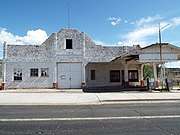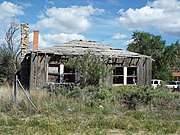Peach Springs, Arizona
Peach Springs (Walapai: Hàkđugwi:v[4]) is a census-designated place (CDP) in Mohave County, Arizona, United States. The population was 1,090 at the 2010 census. Peach Springs serves as the administrative headquarters of the Hualapai (meaning People of the Tall Pine) people, and is located on the Hualapai Reservation.
Peach Springs Walapai: Hàkđugwi:v | |
|---|---|
 The Great Seal of the Halapai Tribe | |
 Location in Mohave County and the state of Arizona | |
 Peach Springs Location in the United States | |
| Coordinates: 35°32′4″N 113°25′24″W | |
| Country | United States |
| State | Arizona |
| County | Mohave |
| Area | |
| • Total | 7.91 sq mi (20.50 km2) |
| • Land | 7.91 sq mi (20.50 km2) |
| • Water | 0.00 sq mi (0.00 km2) |
| Elevation | 4,780 ft (1,457 m) |
| Population (2010) | |
| • Total | 1,090 |
| • Estimate (2016)[2] | N/A |
| Time zone | UTC-7 (MST) |
| • Summer (DST) | UTC−7 (no DST [3]) |
| ZIP code | 86434 |
| Area code(s) | 928 |
| FIPS code | 04-53770 |
| GNIS feature ID | 0009278 |
Geography
Peach Springs is located at 35°32′4″N 113°25′24″W (35.534457, -113.423353).[5]
According to the United States Census Bureau, the CDP has a total area of 6.9 square miles (18 km2), all of it land.
Demographics
| Historical population | |||
|---|---|---|---|
| Census | Pop. | %± | |
| 1990 | 787 | — | |
| 2000 | 600 | −23.8% | |
| 2010 | 1,090 | 81.7% | |
| source:[6] | |||
As of the census[7] of 2000, there were 600 people, 166 households, and 139 families residing in the CDP. The population density was 87.3 people per square mile (33.7/km2). There were 219 housing units at an average density of 31.9/sq mi (12.3/km2). The racial makeup of the CDP was 4.33% White, 93.00% Native American, 2.33% from other races, and 0.33% from two or more races. 5.33% of the population were Hispanic or Latino of any race.
There were 166 households, out of which 48.2% had children under the age of 18 living with them, 38.6% were married couples living together, 35.5% had a female householder with no husband present, and 15.7% were non-families. 12.7% of all households were made up of individuals, and 3.6% had someone living alone who was 65 years of age or older. The average household size was 3.61 and the average family size was 3.83.
In the CDP the population was spread out, with 40.5% under the age of 18, 10.0% from 18 to 24, 25.8% from 25 to 44, 17.3% from 45 to 64, and 6.3% who were 65 years of age or older. The median age was 24 years. For every 100 females, there were 95.4 males. For every 100 females age 18 and over, there were 84.0 males.
The median income for a household in the CDP was $18,194, and the median income for a family was $17,292. Males had a median income of $20,833 versus $15,500 for females. The per capita income for the CDP was $6,756. About 38.2% of families and 36.6% of the population were below the poverty line, including 38.7% of those under age 18 and 55.4% of those age 65 or over.
Services
The town has the Hualapai Lodge, a motel and a small grocery market with fuel. It is the nearest town to Hualapai Hilltop, which is the trailhead from which hikers descend the 8-mile (13 km) trail, with a drop of 2,004 feet (611 m), to the town of Supai, Arizona,[8] from which the renowned Havasu Falls and three other waterfalls can be visited.
Peach Springs is located on the route of the former Atchison, Topeka and Santa Fe Railway (now the BNSF Railway) and on historic US Route 66. Route 66 brought large numbers of cross-country travellers through the town until Interstate 40 was opened 25 miles (40 km) to the south in 1978. I-40 diverges from Route 66 at Seligman 37 miles (60 km) to the east and the two roads do not meet again until Kingman 50 miles (80 km) to the west. As no connecting roads join the two highways at Peach Springs, the town went from being on the beaten path to being more than thirty miles from the new main road overnight. The new road shortened the highway distance from Kingman to Seligman by 14 miles (23 km) at the expense of turning villages like Truxton, Valentine and Hackberry, Arizona, into overnight ghost towns. Peach Springs survived as the administrative base of the Hualapai tribe but suffered irreparable economic damage.
The John Osterman Shell Station, built by a Swedish immigrant in 1929, closed soon after the turn of the millennium. In 2007, the Hualapai Tribe received a $28,000 federal matching grant to rehabilitate the building,[9] which has yet to re-open but which was listed on the National Register of Historic Places in 2012.[10]
In popular culture
A similarly named and situated town, Radiator Springs, is depicted in the 2006 animated film Cars. A map with no local off-ramp from I-40 to a largely-parallel US 66 is described in the film by town attorney Sally Carrera ("the town was bypassed to save ten minutes of driving") to explain vacant, abandoned storefronts after the new road reduced Main Street traffic to zero. As in Peach Springs, the depicted Route 66 runs on a parallel but less-direct route to the north of I-40.
Pixar's research trips covered Arizona, New Mexico, Texas, Oklahoma and Kansas, a little over 1,200 miles (1,900 km) of road passing through both Baxter Springs, Kansas, and Peach Springs, Arizona. In Seligman, Route 66 Association founder Angel Delgadillo explained how abruptly local business died the afternoon Interstate 40 was opened.[11] Scenery and landmarks in the film are heavily influenced by real places in Arizona and in various US states along Route 66.
Historic structures
 John Osterman Shell Gas Station-1929
John Osterman Shell Gas Station-1929 BIA Maintenance Shop - 1936
BIA Maintenance Shop - 1936 Trading Post-1928
Trading Post-1928 Abandoned House-1890
Abandoned House-1890
See also
References
- "2016 U.S. Gazetteer Files". United States Census Bureau. Retrieved Jul 18, 2017.
- "Population and Housing Unit Estimates". Retrieved June 9, 2017.
- "Peach Springs, Arizona Local Time Details". Retrieved June 19, 2019.
- Watahomigie, Lucille, Jorigine Bender, Akira Yamamoto, University of Los Angeles. Hualapai reference grammar. 1982.
- "US Gazetteer files: 2010, 2000, and 1990". United States Census Bureau. 2011-02-12. Retrieved 2011-04-23.
- "CENSUS OF POPULATION AND HOUSING (1790-2000)". U.S. Census Bureau. Retrieved 2010-08-07.
- "U.S. Census website". United States Census Bureau. Retrieved 2008-01-31.
- Witt, Greg (2010). Exploring Havasupai: A Guide to the Heart of the Grand Canyon. Birmingham, Alabama: Menasha Ridge Press. p. 76. ISBN 978-0-89732-654-4.
- "Route 66 Corridor Preservation grant awards" (PDF). US National Park Service. 2007. Retrieved 2012-12-27.
- "Route 66 gas station on historic register". KGUN-TV. April 13, 2012. Archived from the original on January 27, 2013. Retrieved 2012-12-27.
- Ron Warnick (June 9, 2006). "A Route 66 guide to the "Cars" movie".
| Wikivoyage has a travel guide for Peach Springs. |
| Wikimedia Commons has media related to Peach Springs, Arizona. |
